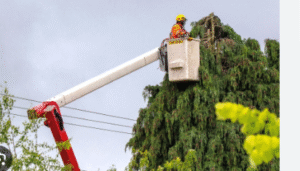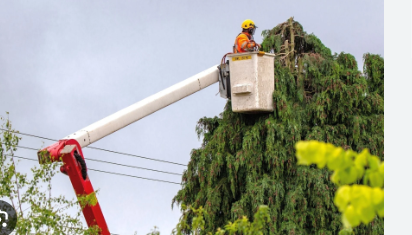worker, homeowner, or otherwise, strong trees that benefit your neighbourhood depend on knowing the correct practices. This book will address professional techniques and doable advice on tree care. Using Maximilian Tree Maintenance, their magnificent canopies and rich vegetation give environments life and homes for different kinds of animals. Still, keeping healthy trees calls for informed methods and sensible maintenance. Whether your goal is to improve your green thumb talents or you are thinking about contacting a certified arborist in Denton, a healthy environment depends on knowing the subtleties of tree maintenance.
Table of contents
Tree Maintenance: An Overview Maintaining trees that shouldn’t be taken for granted requires a certain artistic sense. Trees significantly affect the surroundings; they help to improve property values and air quality. Their magnificent canopies and rich vegetation give the environment life and homes for different kinds of animals. Still, keeping healthy trees calls for informed methods and sensible maintenance. Whether your goal is to improve your green thumb talents or you are thinking about contacting a certified arborist in Denton, a healthy environment depends on knowing the subtleties of tree maintenance.
Emphasising seasonal maintenance,
Emphasising seasonal maintenance, safe behaviour, and refuting common misconceptions will help your trees grow and accentuate the attractiveness of your house. Tree maintenance promotes life that supports ecosystems, not only looks good. Healthy trees create habitats for many species, provide shade, and help to clean the air. Good maintenance drives environmental sustainability and maximises these advantages. Whether your job is landscaping, municipal worker, homeowner, or otherwise, strong trees that benefit your neighbourhood depend on knowing the correct practices. This book will address professional techniques and doable advice on tree care.
Vital Instruments for Tree Maintenance
The correct tools can greatly affect tree maintenance and help to perhaps save time and avoid injury. Among must-have tools are handsaws, loppers, and pruning shears. Every instrument serves a different function: saws are best for addressing bigger limbs; pruners are good for little branches; loppers are fit for thicker branches. Purchasing excellent tools guarantees efficacy and safety as well as increases the lifetime of the tools, so it justifies the investment. By using the correct instrument for the task, you may also avoid needless harm to your trees, therefore enabling their healing and more effective growth.
Advice on seasonal tree maintenance
Trees have certain demands that vary with the seasons, just as any living thing. The health and development of your trees depend on your knowing of and ability to satisfy these seasonal needs. Emphasise springtime fertilising and starting the trimming procedure to get the tree ready for fresh growth. Careful watering and insect control in the summer help to guarantee trees have the resources to flourish in the heat. Autumn is the time to winterise your trees by protecting them against cold harm, such as covering them with a thick layer of mulch, and so preventing freezing of the roots. Careful winter tree maintenance guarantees that trees come into the spring in the finest form imaginable.
Value of Pruning and Trimming
Tree care depends on pruning since it encourages growth and eliminates dead or diseased branches that could provide a bug refuge. Every type of tree has a perfect period for trimming, which reduces tree stress and maximizes health advantages. Crucially for the photosynthesis process of the tree, regular trimming can increase sunlight penetration and airflow across the canopy. It therefore strengthens the tree’s resistance against pests and diseases, so promoting good development. Moreover, good pruning guarantees trees keep their intended form and improve their general stability, thereby improving the appearance of your landscape.
Common Tree Diseases and Their Prevention
Diseases such as powdery mildew, cankers, and root rot can seriously affect tree condition. Controlling tree diseases mostly depends on prevention: making sure the soil is rich and well-drained, watering trees suitably, and maintaining trees far apart. Early disease symptoms can be found by regular inspections, which also enable more efficient management prior to their general spread. The importance of regular inspections cannot be overestimated since quick intervention usually makes the difference between a healthy and a damaged tree.
Safe Tree Maintenance Techniques
Regarding tree upkeep, safety cannot be emphasised too much. To avoid injury, workers handling tools and running machines have to don protective gear. Following safe procedures guarantees a good and quick work process and helps to avoid mishaps. Safe and effective tree maintenance depends on an awareness of machine manuals, safe working practices, and personal constraints. Always keep in mind that, for some tree care-related hazards, calling in a qualified professional is sometimes the safest choice.
Healthy and safe,
Trees have purposes beyond only aesthetic ones for our surroundings. They provide shade, help ecosystems, clean the air, and sometimes raise property value. To stay healthy and safe, however, trees need appropriate care. Tree management calls for an understanding of biology, soil science, pruning techniques, and safety procedures; it is both an art and a science. Long-term sustainability and attractiveness depend on knowing how to care for trees, regardless of your level of involvement—homeowners, gardeners, or budding arborists.
The Importance of Tree Maintenance
Maintenance of trees extends beyond appearances. Neglected trees can become risks, spreading disease or toppling during heavy rain. Overgrown limbs could ruin property or interfere with electrical lines. Conversely, well-kept trees improve the surroundings, live longer, and get stronger.
Important causes of the preservation of trees include:
Health: Eliminating dead or diseased limbs stops the spread of infections and bug problems.
Safety: Cutting low- or weak-hanging branches lessens limb fall risk.
Pruning done correctly encourages good structure and controlled development.
A well-maintained tree improves the visual attractiveness of the surroundings.
Healthy trees help more with air pollution control and biodiversity.

The Skill of Tree Maintenance: Useful Advice and Methodologies
Simple Tree Maintenance Projects
Although some tree maintenance chores call for expert assistance, many daily jobs may be completed by homeowners armed with simple equipment and expertise. These consist of:
1. Hydration
To develop roots, young trees must be regularly watered, especially in dry spells. Though they are usually more drought-resistant, mature trees nevertheless gain from thorough, rare irrigation.
To cut evaporation, water either early in the morning or late in the evening. Approach: Deliver water straight to the root zone using drip irrigation or a soaker hose.
2. Mulching
Mulch controls temperature, helps to retain soil moisture, and stop weed development. It also lessens nutrient-related competition.
Advice: Spread 2–4 inches of organic mulch—wood chips or bark. Steer clear of piling mulch against the trunk since it will decay.
3. Sheading
Among the most important facets of tree care is pruning. Branches are taken out specifically to form the tree, promote growth, and remove risks. For most trees, late winter or early spring, dormant season is best.
Use saws or sharp, clean pruning shears. approach: Remove dead or weak branches in your crown cleaning.Crown thinning: Remove branches strategically to increase air flow.
4. Feeding
Particularly in metropolitan settings, fertilisers offer necessary nutrients that can be deficient in the soil. Before adding fertilisers, do a soil test.
Approach: Early spring or late autumn, slow-release fertilisers.
5. Disease and Pest Control
Common tree pests include mites, borers, and aphids. Unchecked, diseases include powdery mildew and cankers can weaken or destroy a tree.
Solution: Look at trees often for symptoms. Treatment: Remove afflicted branches as away and apply either chemical or organic controls as needed.
Bracing and Cables
Weak limbs on some mature trees could call for structural assistance. Bracing and cabling are methods of adding stiff rods or flexible steel cables to lessen branch strain. Note: An accredited arborist should conduct this job. Modern Tree Care Techniques. More advanced care methods could be needed for bigger or valuable trees. Root Zone Control Absorption of nutrients depends critically on the root zone. Compacted soil might restrict oxygen supply and root spread. Method: Apply organic compost or biochar, then loosen compacted soil using air spading.
Risk Evaluation of Trees
Risk assessment instruments help certified arborists analyse possible targets (such as homes or vehicles) and tree collapse probabilities. After storms or obvious tilting. Analyse branch structure, root health, and indicators of internal degradation.
Injections into Trees
Direct injection into the trunk can offer focused treatment when trees have illnesses or nutritional shortages. Common with iron chlorosis or Dutch elm disease. Use caution; overuse may compromise the tree’s vascular system.
Inoculation by Mycorrhizal Agents
This method brings useful fungus to tree roots, therefore enhancing stress tolerance and nutrient absorption. Advantage: improves tree health and growth especially in low soils. Tips for Seasonal Tree Maintenance
Every season carries various care needs: Spring, Inspect for winter damage. Apply slow-release fertiliser. Start with control of pests and diseases. Summer: During dry spells, water thoroughly. Look for fungus and insect problems. Steer clear of big pruning during hot weather. Fall prune broken or dead branches. Get mulch before the first freeze.
Avoid Sickness,
To avoid sickness, clean dropped leaves. Wrap young, thin-barked trees to guard against sunscald. Steer clear of too aggressive pruning. Look for storm damage following snowfall or icefall. Priority One: Safety
Especially at heights or with power tools, tree maintenance can be hazardous. Give safety top priority always. Don gloves, goggles, and hard helmets. With care, use chainsaws and ladders. Never cut close to electricity wires; call the utility company or a professional.
When Should One See a Professional?
While modest chores allow for do-it-yourself maintenance, other circumstances call for professional attention: trees next to buildings or electricity cables. Deadwood at height or big limbs. Symptoms of illness requiring diagnosis. structural weakness (split trunk, tilting). Certified arborists have the tools and training needed to safely and successfully address difficult problems.
A continual commitment, tree maintenance provides long-term benefits in environmental impact, safety, and beauty. Even inexperienced gardeners may significantly help to raise healthy trees with the correct guidance and methods. From mulching and watering to trimming and disease control, every step you do makes sure your trees flourish. Still, equally crucial is knowing your limitations and when to see a specialist. Learning the ability of tree management is more important than ever as urban expansion and climatic issues get more pressing.
Essential Elements
Essential elements of a balanced ecosystem and beloved accents of our landscapes are trees. Good care guarantees not only their existence but also increases their advantages for the next generations. Adopting healthy habits—watering sensibly, pruning precisely, and controlling pests—you invest in the lifetime and safety of your surroundings. Tree maintenance is a talent worth learning, whether you are tending an urban boulevard or a garden oak.
Final thought
How should I handle roots breaking my pavement? Never cut big roots on your own. See a professional who might reroute the course, apply safer pruning techniques, or utilise root barriers. Should I mulch all year long? Indeed, but autumn is better for insulating roots. Make sure you avoid building a “volcano” form around the trunk or over-mulching. Are all pests related to trees dangerous? Not sure. Some insects are either harmless or even helpful. Before starting treatment, precise identification is essential. Search for a qualified arborist where I live? Search for ISA-certified arborists or speak with neighbourhood tree care organisations. Steer clear of unregistered people providing doorstep services.
Conclusion
Are storm-damaged trees able to recover? Indeed, with good trimming and maintenance, many trees can bounce back. Eliminate damaged branches right away and evaluate structural integrity. Not sure. Some insects are either harmless or even helpful. Before starting treatment, precise identification is essential. Search for a qualified arborist where I live? Search for ISA-certified arborists or speak with neighbourhood tree care organisations. Steer clear of unregistered people providing doorstep services. Still, equally crucial is knowing your limitations and when to see a specialist. Learning the ability of tree management is more important than ever as urban expansion and climatic issues become more pressing.
FQS
1. How often should I cut back my trees?
Depending on species, age, and growth pace, most trees gain from trimming every one to three years. Younger trees can call for more regular shaping.
2. Is summer pruning of a tree appropriate?
While summer is a good time for light pruning, steer clear of significant cuts during the hottest months. The ideal is dormant-season pruning, late winter.
3. How might one spot tree diseases?
Look for insect activity, cankers, leaf discolouration, and odd growths. See a qualified arborist for diagnosis if not sure.
4. Can I feed trees grass fertiliser?
Not advised. Different nutrient needs apply to trees. Apply fertilisers depending on a soil test or specially designed for woody plants.
5. How would I find out a tree is dead?
Signs include brittle branches, peeling bark, no leaves in a growing season, and fungal growth at the base. Scratch the bark; the branch most certainly is dead if there is no green layer beneath.






Leave a Reply